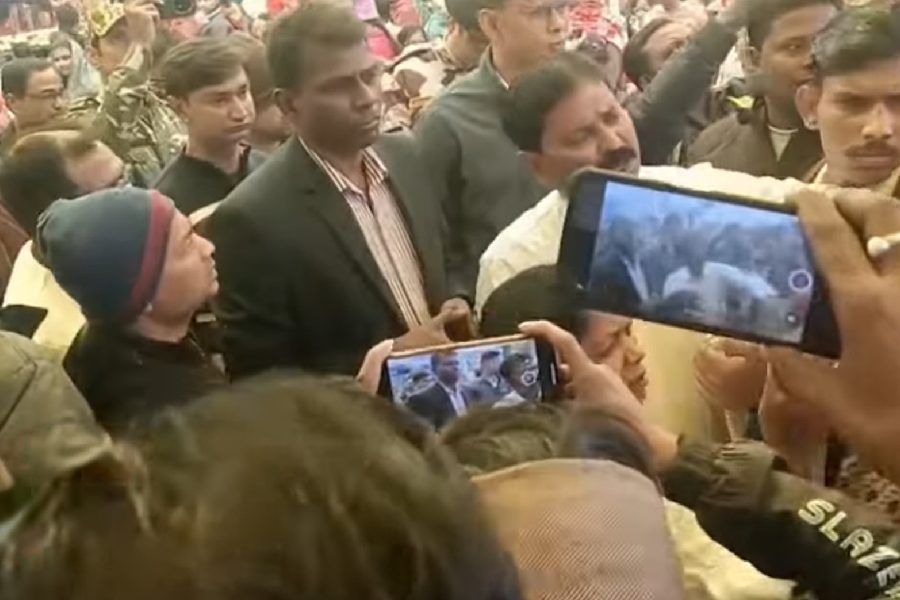Extreme times demand extremes of scale, whether tiny or titanic. That’s why Bose Krishnamachari matches his weighty concerns with large exhibits and their grand display at his solo show being hosted at Kolkata Centre for Creativity till March 8. The tone is set at the entrance with two massive granite boulders, hewn on top into flat plaques with epigraphs recalling Ashokan proclamations. They list the social categories that can turn into divisive tools in these dark times. Another show — of the Society of Contemporary Artists — was equally partial to imposing sizes at its December Annual at Birla Academy: this is, after all, the group’s 60th year.
First, Krishnamachari. Why does the Bombay-based artist insist that The Mirror Sees Best in the Dark? Could it be because the comforting anonymity of darkness counters fear and favour in its reflections? No chiaroscuro, no refraction, no staged view with which hyperreality beguiles the eye. Could holding up a mirror to society be so precarious now, that it’s darkness alone that can be reported truthfully?
The wallpaper Krishnamachi uses as a backdrop sends mixed signals: its gold floral design is richly period, very regal, but the black ground is inauspicious, portends death. These contrary tugs come loaded with suggestions reinforced by a large, ornate box frame that holds more than one two-way mirror to aid optical illusion. A neon sign that says Religion in cursive script is reflected in receding, fading, penumbral echoes: the atavistic allegiance to religious identity imprints persistent riffs in the psyche, presumably.
Nor can other typological terms — like caste — be read with academic neutrality since they don’t exist in a vacuum, but trail insidious allusions as labels. That’s what a set of mirrors in a darkened hall indicates in screaming, multi-font ad-design letters. In the eponymous installation, framed glass sheets fixed at right angles to the wall look like shutters that can keep out the real world while cocooning a familiar darkness within. Perhaps that is why the artist also displays a series of tablets with the precise patterns of the Braille code, but disrupted with irregular ridges that imitate termite tunnels. Do the sightless understand the discourse around termites more accurately without the beguiled eye?
The SCA show was dedicated to the sculptor who always reserved a surprise in his articulate chisel. Long-time member Manik Talukdar (1944-2019), who died shortly before the show, buoyed his wood carving with a Chaplinesque tragi-comic spirit. Niranjan Pradhan’s 62-inch-tall, robotic figure, made with steel rods and blocks of wood, appeared amusingly bewildered, as though wondering where man was headed with his runaway technology.
For this show, Bimal Kundu shifted to fibreglass to magnify the scale of his sculptures: a green reclining woman and a massive, 120”x48”x36” head of Tagore, ideal for outdoor sites. The Tagore head, especially. With slightly sunken cheeks and narrowed eyes that seem fiercely, even grimly intense, lost in a deep trance, the poet appears as a forbiddingly aloof messiah. Fibreglass was also Pankaj Panwar’s choice for his life-size figures in Battle of Angels. Its biblical resonance is edged with irreverence as a struggle between contenders for power rather than causes.
Manoj Mitra’s light-hearted Kali images and Manu Parekh’s Varanasi scene mine the colourful ceremony of Hindu worship. Manoj Dutta’s child-art simplification is guided by a winsome rubric. Out of the spontaneous sweep of Atanu Bhattacharya’s brush emerge fantasy creatures from inchoate shapes, while watercolour is explored with finesse by Pradip Maitra and young Bholanath Rudra. Two other young members with noticeable works are Saumen Khamrui, with his maze of interlocked, textured geometric divisions and David Malakar who plays around with perspective, size and tones.










